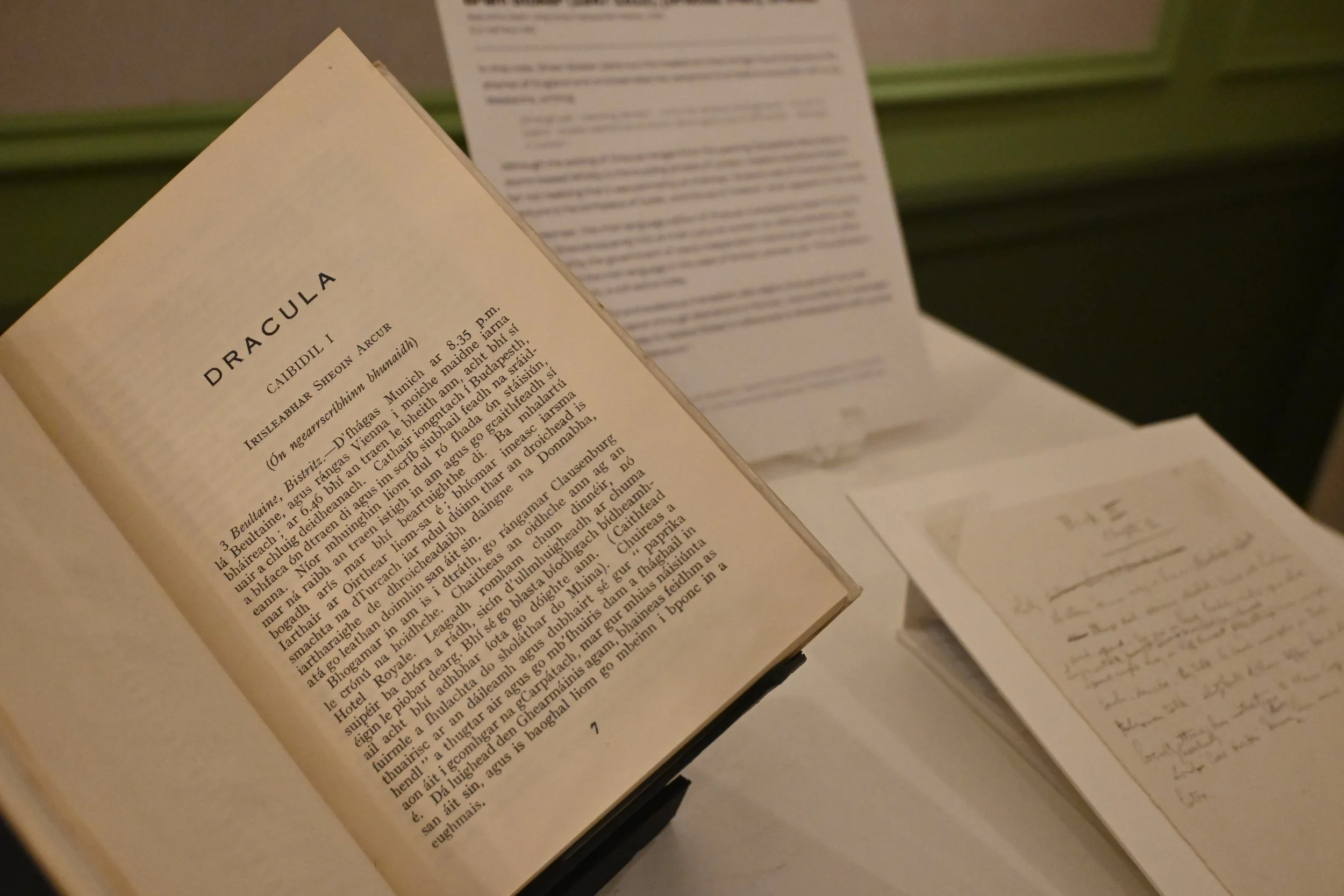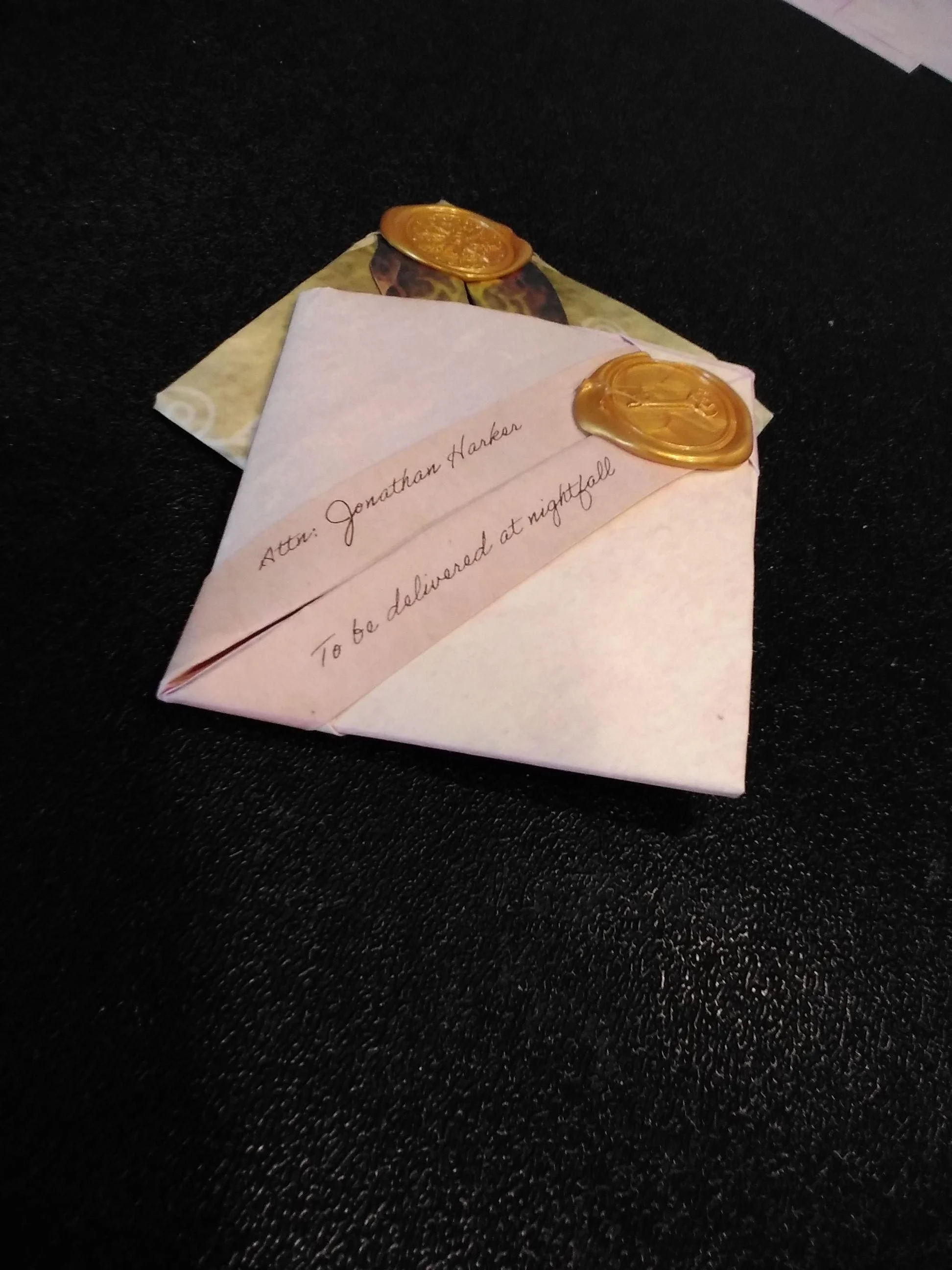“The Feelings of the Hunter”: Some Additional Thoughts on “On the Twisted Trail of Bram Stoker’s Notes for ‘Dracula’”
by Nancy Loi, Associate Librarian
Bram Stoker (1847-1912), [Dracula. Irish]. Dracula. Baile Átha Cliath: Oifig Díolta Foillseacháin Rialtais, 1933. EL3 .S874d.Ir 933. Image credit: Bryn Michelson-Ziegler and David Rhys Owen.
On October 16, the online magazine Mental Floss featured the Rosenbach in an article by journalist Sher Hackwell about Bram Stoker’s (1847-1912) manuscript notes and outline for his iconic horror novel, Dracula (1897) [EL3 .S874d MS], highlights of our collection.
For me and the Rosenbach, the article started out as a research query from Sher in August about our Stoker and vampire literature holdings. She was particularly interested in how the Rosenbach became the home for the Dracula notes.
Provenance questions are some of my favorites. It can often be complicated and frustrating to trace the ownership and custodial history of a rare book or manuscript, but it is also very satisfying when the detective work yields results. And, fittingly, the Stoker notes have a past full of mysteries.
Bram Stoker's "Dracula”: a centennial exhibition at the Rosenbach Museum & Library, April 10-November 2, 1997. Philadelphia: Rosenbach Museum & Library, 1997. Ro4 1997g. Front jacket illustration copyright Maurice Sendak, 1997.
The Rosenbach’s Librarian Elizabeth E. Fuller and other predecessors (including former curator Patricia C. Willis and volunteer researcher Lynn Henson) laid the groundwork for answering Sher’s query. Elizabeth researched and wrote an essay on the provenance of Stoker notes for the catalog that accompanied the Rosenbach's Dracula centennial exhibition in 1997, marking a century since the publication of Stoker's novel [Ro4 1997g]. She noted that, at the time, the Rosenbach wasn’t able to present a complete, connected narrative of the notes’ ownership but welcomed additional information.
H.P. Lovecraft scholar Kenneth W. Faig, Jr. sent a copy of the exhibition catalog to his friend Douglas A. Anderson in Indiana, who proceeded to write to Elizabeth and provide the crucial clue about steel executive and book collector Harry Bacon Collamore’s one-time ownership of the Stoker notes. Anderson’s letter was added to the Rosenbach’s collection file for the Stoker manuscript, waiting to help Sher, nearly three decades later, in 2025. I hope to share more about Collamore soon. He not only owned the Dracula notes at one point but also became a Rosenbach board member in 1970 and gifted the museum a first edition of Dracula, the only one known to retain its dust jacket [EL3 .S874d 897a copy 1].
Sample letterpacket from Rosenbach calligraphy and letterlocking course Letters from a Vampyre. Image credit: Bryn Michelson-Ziegler.
The Dracula notes are incredibly popular with the Rosenbach’s community, inspiring numerous public program offerings, including “Letters from a Vampyre,” a recent course in calligraphy and letterlocking that gave participants an opportunity to create their own secret messages. Visitors can always see a selection from our Stoker holdings in the Rosenbach’s Treasures galleries, and researchers are welcome to make an appointment to study the materials in our reading room. For those interested in learning more about what that experience is like, Allison Hartman Adams described her visit in an article for Irish American science fiction fanzine Journey Planet’s October 2024 issue “Dracula: Fiend and Foe.”
Bram Stoker (1847-1912), Original holograph manuscript of "Mesmer" from "Practitioners of Magic", chapter 2, part C of Famous Imposters. 1910. EMs 1351/13. Purchased in memory of Bram Stoker scholars, authors, and friends of the Rosenbach Elizabeth Miller, Robert Eighteen-Bisang, and David Skal with support from their fellow scholars, the Stoker family, and the Wyncote Foundation. Image credit: David Rhys Owen.
Last year, the Rosenbach acquired another Stoker manuscript [EMs 1351/13] in memory of Bram Stoker scholars, authors, and friends of the Rosenbach, Elizabeth Miller, Robert Eighteen-Bisang, and David Skal with support from their fellow scholars, the Stoker family, and the Wyncote Foundation. I was very glad to see that Miller and Eighteen-Bisang and their work have a well-deserved cameo in the Mental Floss article. We regularly encourage researchers to consult the facsimile edition of Stoker's notes [PR6037.T617 Z46 2008], which Miller and Eighteen-Bisang edited, even if they come to see the notes in person, since Stoker’s handwriting isn’t always easy to decipher.
The provenance trail of Bram Stoker’s notes is certainly twisted, but it’s thrilling to shine some light on the librarians, researchers, booksellers, and collectors who all played a role in the story of the Dracula notes—and be a small part of it myself.




